| Huincul Formation | |
|---|---|
| Stratigraphic range: Late Cenomanian-Early Turonian ~ | |
| Type | Geological formation |
| Unit of | Neuquén Group Río Limay Subgroup |
| Underlies | Lisandro Formation |
| Overlies | Candeleros Formation |
| Thickness | 250 m (820 ft) |
| Lithology | |
| Primary | Sandstone |
| Other | Claystone |
| Location | |
| Coordinates | 39°24′S 69°00′W / 39.4°S 69.0°W |
| Approximate paleocoordinates | 46°06′S 46°00′W / 46.1°S 46.0°W |
| Region | Mendoza, Río Negro & Neuquén Provinces |
| Country | Argentina |
| Extent | Neuquén Basin |
| Type section | |
| Named for | Plaza Huincul |
| Named by | Keidel |
| Year defined | 1929 |
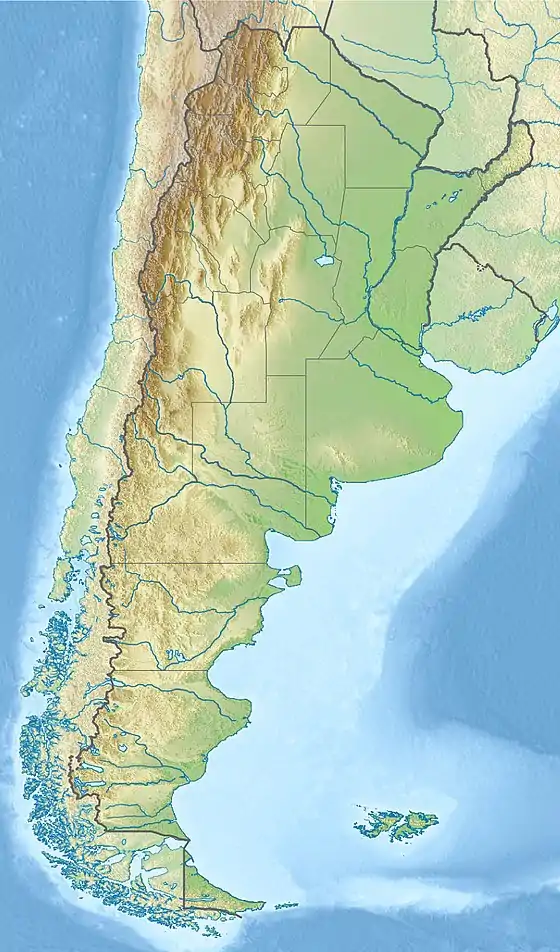 Huincul Formation (Argentina) | |
The Huincul Formation is a geologic formation of Late Cretaceous (Early Cenomanian to Late Turonian) age of the Neuquén Basin that outcrops in the Mendoza, Río Negro and Neuquén Provinces of northern Patagonia, Argentina.[1] It is the second formation in the Río Limay Subgroup, the oldest subgroup within the Neuquén Group. Formerly that subgroup was treated as a formation, and the Huincul Formation was known as the Huincul Member.[2]
Description
The type locality of the Huincul Formation is near the town of Plaza Huincul in Neuquén Province after which the formation was named by Wichmann in 1929.[3] This formation conformably overlies the Candeleros Formation, and it is in turn overlain by the Lisandro Formation.
The Huincul Formation is thought to represent an arid environment with ephemeral or seasonal streams.[4] In some areas, it is up to 250 metres (820 ft) thick. It is mainly composed of green and yellow sandstones and can easily be differentiated from the overlying Lisandro Formation, which is red in color. The Candeleros Formation, underlying the Huincul, is composed of darker sediments, making all three formations easily distinguishable.[2][5]
Paleobiota
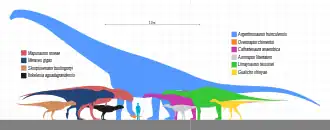
Dinosaur fossils are frequently found in the Huincul Formation. The titanosaurian sauropod Argentinosaurus huinculensis, one of the largest known land animals, is named after the formation.[2] Another noteworthy Huincul dinosaur is the carcharodontosaurid theropod Mapusaurus roseae, which is regarded as one of the largest known terrestrial predators.[4]
Dinosaurs
Apart from sauropods and theropods, rare fossils of iguanodonts and other ornithopods have been recorded in the formation.[6] Ichnofossils (footprints) of abelisaurid theropods and hadrosaurs are also known.[7]
Sauropods
Color key
|
Notes Uncertain or tentative taxa are in small text; |
| Sauropods of the Huincul Formation | ||||
|---|---|---|---|---|
| Genus | Species | Material | Notes | Images |
| Argentinosaurus | A. huinculensis | Seven dorsal vertebrae, partial sacrum, partial dorsal rib, fibula and potentially other hindlimb bones | A titanosaur | 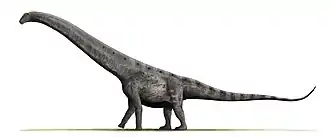 |
| Bustingorrytitan | B. shiva | Four specimens are known, together including parts of the dentary and postcranial skeleton. | A titanosaur | .jpg.webp) |
| Cathartesaura | C. anaerobica[8] | A rebbachisaurid | ||
| Choconsaurus | C. baileywillisi[9] | Partial skeleton without skull, MMCh-PV 44/10. | A titanosaur |  |
| Chucarosaurus | C. diripienda | A complete left humerus, partial left radius, complete left metacarpal II, left ischium, partial left femur and fibula, partial right tibia, and partial indeterminate metapodial.[10] | A titanosaur. | 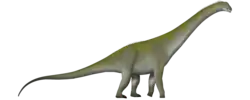 |
| Limaysaurus | L. tessonei | A rebbachisaurid | 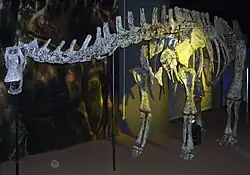 Limaysaurus | |
| Sidersaura | S. marae | Two partial skeletons | A rebbachisaurid |  |
Theropods
| Theropods of the Huincul Formation | ||||
|---|---|---|---|---|
| Taxa | Species | Material | Notes | Images |
| Aoniraptor | A. liberataem | Sacral vertebra, six proximal caudal vertebrae, four mid-caudal vertebrae.[11] | A fragmentary theropod originally described as a megaraptoran. | |
| Gualicho | G. shinyae | A partial skeleton lacking the skull along with four vertebrae of the back, three vertebrae of the middle tail, ribs, a basket of belly ribs, the left shoulder girdle, the left forelimb, the right lower arm, the lower ends of both pubic bones, the right thighbone, the lower end of the left thighbone, the upper ends of the right shinbone and calf bone, elements of both metatarsi and three toes of the right foot (Holotype MPCN PV 0001). | A theropod of uncertain affinities |  |
| Huinculsaurus | H. montesi | Several vertebrae[12] | A noasaurid | 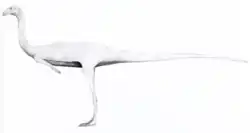 |
| Ilokelesia | I. aguadagrandensis | Fragmented skull and the axial, appendicular skeleton. | An abelisaurid |  Ilokelesia |
| Mapusaurus[13] | M. roseae | Multiple skeletal specimens. | A carcharodontosaurid | 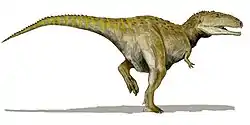 |
| Meraxes | M. gigas[14] | A nearly complete skull, pectoral and pelvic elements, partial forelimbs, complete hindlimbs, fragmentary ribs, and cervical and dorsal vertebrae, a sacrum, and several complete caudal vertebrae. | A carcharodontosaurid | 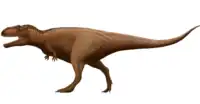 Meraxes_gigas_reconstruction |
| Overoraptor | O. chimentoi[15] | A paravian. |  | |
| Skorpiovenator | S. bustingorryi | A preserved skeleton. | An abelisaurid |  |
| Taurovenator[11] | T. violantei[11] | A carcharodontosaurid | ||
| Tralkasaurus | T. cuyi | An incomplete skeleton ( MPCA-Pv 815), which comprises a maxilla; dorsal, sacral, and caudal vertebrae; cervical ribs; and a badly-preserved pubis. | An abelisaurid | |
Other reptiles
Apart from the taxa named here, fossils of unnamed squamates and neosuchian crocodyliforms have been discovered in the formation.[16]
| Non-dinosaur reptiles of the Huincul Formation | ||||
|---|---|---|---|---|
| Genus | Species | Material | Notes | Images |
| Kaikaifilusaurus | K. sp. | Incomplete right dentary[17] | An eilenodontine rhynchocephalian | |
| Patagosphenos[17] | P. watuku | Disarticulated skull with shoulder and limb fragments | An eilenodontine rhynchocephalian | |
| Prochelidella | P. buitreraensis[18] | Skull, two cervical vertebrae, partial left forelimb, right pelvic girdle, shell fragments | A chelid turtle | |
See also
References
- ↑ Huincul Formation at Fossilworks.org
- 1 2 3 Sánchez et al., 2006
- ↑ Wichmann, 1929
- 1 2 Coria & Currie, 2006
- ↑ Leanza et al., 2004, p.68
- ↑ Canudo, J. I., Salgado, L., Garrido, A., Carballido, J. L., Aragosaurus-IUCA, G., Lobo, I., Negro, R., & Olsacher, J. A. (2013). Primera evidencia de dinosaurios ornitópodos en la base de la Formación Huincul (Cenomaniense Superior-Turoniense, Cuenca Neuquina, Argentina) First evidence of ornithopod dinosaurs at the base of Huincul Formation (Cenomanian - Upper Turonian, Neuquén Basin, Argentina).
- ↑ Leonardi, 1994, p.30
- ↑ Gallina, Pablo A.; Apesteguía, Sebastián (2005). "Cathartesaura anaerobica gen. et sp. nov.,a new rebbachisaurid (Dinosauria, Sauropoda) from the Huincul Formation (Upper Cretaceous), Rio Negro, Argentina". Revista del Museo Argentino de Ciencias Naturales. Nueva Series. 7 (2): 153–166. doi:10.22179/REVMACN.7.332.
- ↑ Simón, Edith; Salgado, Leonardo; Calvo, Jorge O. (2017). "A new titanosaur sauropod from the Upper Cretaceous of Patagonia, Neuquén Province, Argentina". Ameghiniana. 55: 1–29. Retrieved 2020-03-16. doi:10.5710/AMGH.01.08.2017.3051
- ↑ Agnolin, Federico L.; Gonzalez Riga, Bernardo J.; Aranciaga Rolando, Alexis M.; Rozadilla, Sebastián; Motta, Matías J.; Chimento, Nicolás R.; Novas, Fernando E. (2023-02-02). "A new giant titanosaur (Dinosauria, Sauropoda) from the Upper Cretaceous of Northwestern Patagonia, Argentina". Cretaceous Research: 105487. doi:10.1016/j.cretres.2023.105487. ISSN 0195-6671.
- 1 2 3 Motta, Matías J.; Aranciaga Rolando, Alexis M.; Rozadilla, Sebastián; Agnolín, Federico E.; Chimento, Nicolás R.; Egli, Federico Brissón; Novas, Fernando E. (June 2016). "New theropod fauna from the Upper Cretaceous (Huincul Formation) of northwestern Patagonia, Argentina". New Mexico Museum of Natural History and Science Bulletin. 71: 231–253 – via ResearchGate.
- ↑ Mattia Baiano; Rodolfo Coria; Andrea Cau (2020). "A new abelisauroid (Dinosauria: Theropoda) from the Huincul formation (lower upper Cretaceous, Neuquén Basin) of Patagonia, Argentina". Cretaceous Research. doi:10.1016/j.cretres.2020.104408.
- ↑ Canale et al., 2012
- ↑ Canale, J.I.; Apesteguía, S.; Gallina, P.A.; Mitchell, J.; Smith, N.D.; Cullen, T.M.; Shinya, A.; Haluza, A.; Gianechini, F.A.; Makovicky, P.J. (2022). "New giant carnivorous dinosaur reveals convergent evolutionary trends in theropod arm reduction". Current Biology. doi:10.1016/j.cub.2022.05.057.
- ↑ Matías J. Motta; Federico L. Agnolín; Federico Brissón Egli; Fernando E. Novas (2020). "New theropod dinosaur from the Upper Cretaceous of Patagonia sheds light on the paravian radiation in Gondwana". The Science of Nature. 107 (3): Article number 24. Bibcode:2020SciNa.107...24M. doi:10.1007/s00114-020-01682-1. hdl:11336/135530. PMID 32468191. S2CID 218913199.
- ↑ Motta, M.J.; Brissón Egli, F.; Aranciaga Rolando, A.M.; Rozadilla, S.; Gentil, A. R.; Lio, G.; Cerroni, M.; Garcia Marsà, J.; Agnolín, F. L.; D'Angelo, J. S.; Álvarez-Herrera, G. P.; Alsina, C.H.; Novas, F.E. (2019). "New vertebrate remains from the Huincul Formation (Cenomanian–Turonian;Upper Cretaceous) in Río Negro, Argentina". Publicación Electrónica de la Asociación Paleontológica Argentina. 19 (1): R26. doi:10.5710/PEAPA.15.04.2019.295. hdl:11336/161858. S2CID 127726069. Archived from the original on December 14, 2019. Retrieved December 14, 2019.
- 1 2 Gentil, Adriel R.; Agnolin, Federico L.; Garcia Marsà, Jordi A.; Motta, Matias J.; Novas, Fernando E. (2019). "Bridging the gap: Sphenodont remains from the Turonian (Upper Cretaceous) of Patagonia. Palaeobiological inferences". Cretaceous Research. 98: 72–83. doi:10.1016/j.cretres.2019.01.016.
- ↑ Maniel, Ignacio J.; de la Fuente, Marcelo S.; Apesteguía, Sebastian; Mayoral, Joaquin Pérez; Sanchez, Maria L.; Veiga, Gonzalo D.; Smales, Ian (2020-06-17). "Cranial and postcranial remains of a new species of Prochelidella (Testudines: Pleurodira: Chelidae) from 'La Buitrera' (Cenomanian of Patagonia, Argentina), with comments on the monophyly of this extinct chelid genus from southern Gondwana". Journal of Systematic Palaeontology. 18 (12): 1033–1055. doi:10.1080/14772019.2020.1721579. ISSN 1477-2019.
Bibliography
- Canale, Juan Ignacio; Apesteguía, Sebastián; Makovicky, Peter; Gallina, Pablo Ariel; Gianechini, Federico; Smith, Natan; Maniel, Ignacio; Haluza, Alejandro (2012). "New carcharodontosaurid theropod remains from El Chocón Neuquén Group, Huincul Formation, Neuquén, Argentina". Ameghiniana. 50.
- Coria, R.A.; Currie, P.J. (2006). "A new carcharodontosaurid (Dinosauria, Theropoda) from the Upper Cretaceous of Argentina". Geodiversitas. 28: 71–118. Retrieved 2019-02-16.
- Leanza, H.A.; Apesteguia, S.; Novas, F.E.; De la Fuente, M.S. (2004). "Cretaceous terrestrial beds from the Neuquén Basin (Argentina) and their tetrapod assemblages". Cretaceous Research. 25: 61–87. Retrieved 2019-02-16.
- Leonardi, Giuseppe (1994). "Annotated Atlas of South America Tetrapod Footprints (Devonian to Holocene) with an appendix on Mexico and Central America". Ministerio de Minas e Energia - Companhia de Pesquisa de Recursos Minerais, Geological Service of Brazil. pp. 1–248. Retrieved 2019-03-25.
- Sánchez, María Lidia; Heredia, Susana; Calvo, Jorge O. (2006). "Paleoambientes sedimentarios del Cretácico Superior de la Formación Plottier (Grupo Neuquén), Departamento Confluencia, Neuquén" [Sedimentary paleoenvironments in the Upper Cretaceous Plottier Formation (Neuquen Group), Confluencia, Neuquén)]. Revista de la Asociación Geológica Argentina. pp. 3–18. Retrieved 2019-02-16.
- Wichmann, R (1929). "Los Estratos con Dinosaurios y su techo en el este del Territorio del Neuquén ("The dinosaur-bearing strata and their upper limit in eastern Neuquén Territory")". Dirección General de Geología, Minería e Hidrogeología Publicación. 32: 1–9.